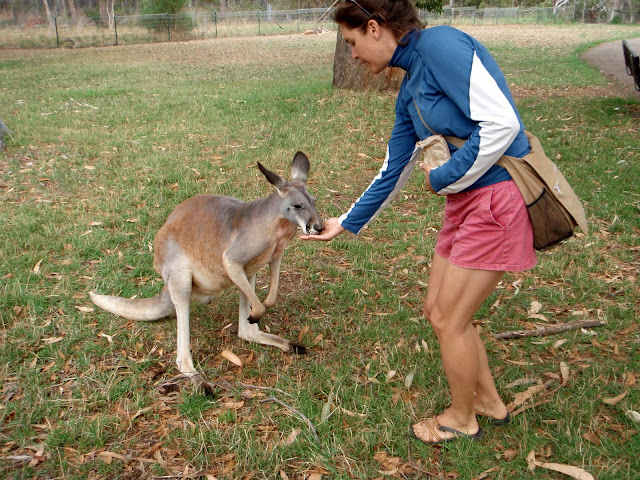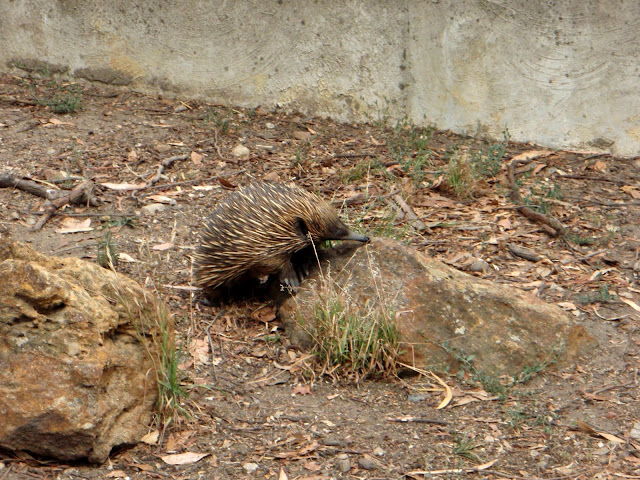
Today we spent the morning at
Cleland Wildlife Park with Will and Molly. I met Will playing ultimate—he is from Minnesota, which here in Australia makes him sound like he has a funny accent. I think it’s a sign that you’re getting used to your location when American accents begin to sound a bit odd. Molly was just in town from Brisbane for the weekend for a training camp for the Australian ultimate team that is headed to Prague for coed Worlds in July.
Anyway, Will used to be a volunteer up at Cleland, so he volunteered to be our guide for the day. Cleland is one of a string of National Parks along western side of the Adelaide Hills—in this case, the entrance to Cleland is just a few kilometers from the summit of Mt. Lofty. We tried stopping at the summit on the way in, but it was still shrouded in fog. Fog in the summer is a good sign, because it means there is a lot of moisture in the air and it will be raining soon somewhere, probably in the Hills in a place like Blackwood, where we live.

The best part about Cleland is that for a great deal of the time you are in the pens with the animals. Things that you wouldn’t want to meet face to face—like Tasmanian Devils or aggressive, three meter long, highly venomous snakes—are suitably confined. But for the most part, you can walk among the kangaroos, wallabies, emus, potoroos, egrets, and other endemic Australian animals. It's a bit like a petting zoo--not exactly the wild, but still very fun.
And that’s what we did. Starting with the Tasmanian Devil in his enclosure. Apparently the ‘devil’ part comes from the sound that they make, but they look quite friendly, aside from the massively overdeveloped jaws. There is a strong effort to create a genetically viable population on mainland Australia due to the spread of facial tumor disease through nearly the entire Tasmanian population. The spread of devil facial tumor disease is handily aided by the fact that Tasmanian Devils greet one another with bites to the face. Whatever benefit that particular habit has, it seems to have come face-to-face with natural selection (no pun intended).

Without a doubt, the highlight of the day was the kangaroos. Most kangaroos are quite wary of humans, but those at Cleland are quite used to our sort, so much so that our first up-close contact with a kangaroo was when one hopped over toward us to check us out. The kangaroos were actually interested in our feed bags, but it suited us all the same, because we were hand feeding them, which was great. They are sort of like Tyrannosaurus Rex with their tiny little arms. It was so cute, though, because they would put their mini little paws on your hand and then eat right from it. One scene that wasn’t cute at all was this very big, old, slow, male kangaroo that kept trying to mate with this very small, young female. He would take these very slow laborious steps towards the young female, and just as he would reach out his arms to her, she would take just a few, quick hops just out of reach. He would again slowly make his way to her, only for her to hop just out of reach.

Kangaroos are part of an herbivorous group of marsupials known as
macropods (family Macropodidae) that have an enormous middle toe that makes up most of their foot (there might be some fused digits in there). The macropods include kangaroos, wallabies,
euros, and a few other hopping marsupials. Another characteristic shared by most macropods is a long, muscular tail. We picked a tail up and they are seriously buff. They actually use their tails as a fifth ‘leg’ when they are walking forward, supporting themselves on their tail and two front limbs as they move their enormous hind feet forwards. And, of course, they use their tails to balance while hopping. A hopping kangaroo (or wallaby) is a sight to see. The tendons in their hind legs have developed to be able to handle enormous loads to the point where kangaroos store energy in their leg tendons as they hit the ground and then get that energy back when they hop forward again. This allows kangaroos to hop quite quickly with very little additional energy expenditure; imagine if there was only a very small difference in exertion between running 10-minute miles and 7-minute miles! Carrying a load such as a joey in a pouch also requires very little extra muscular exertion, because the extra weight means extra stored gravitational energy.

I have to add that a marsupial with a joey in its pouch looks sort of funny. We have this idealized impression from cartoons and whatnot that the joey peers over the edge of the pouch with its head out and front paws hanging onto the edge. Well, the head usually sticks out, but so do the enormous hind legs, often right next to the head. It looks a bit like someone took a rag doll and just stuffed it in there. The flexibility of a joey’s spine must be truly amazing…
The birds at Cleland were quite varied. In addition to birds we had already encountered in Australia (like ducks, egrets, and pelicans), there were also
Cape Barren Geese with their green bills, human-sized emus, and lots of
Superb Fairywrens, which are bright blue and wiggle their tails back and forth very quickly. This behavior has won them the common Australian name of “Willy Wag-tail.” It's a bit tough to photograph a fairywren because they are so small and fast.
We saw lots of other animals including wombats, echidnas, dingoes, koalas, and even a numbat. Wombats look a bit like capybaras and are pretty solid. However, modern wombats are actually the miniature version--one of the classic members of the now-extinct Australian megafauna is
Diprotodon, which is essentially a wombat larger than a buffalo (!). On the other hand, a numbat looks nothing like a wombat—it is probably about 1/50th of the mass of a wombat and is actually quite a delicate little rodent. They are actually extinct in the wild in South Australia, like a number of other endemic Australian species. Chelsea thinks their extinction may have had something to do with their name, which really sounds like a combination of numbskull and dingbat. One of my favorite animals was the Spinifex hopping mice, a desert rodent that lives in the protection of the sharp spinifex plant. The spinifex plant (and the mice) are unique to Australia, and inspired the ‘spinifex texture’ that characterizes many komatiites (more on spinifex and komatiites in a future post).


